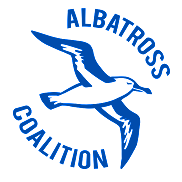Download: Albatross Coalition President Obama Letter 2017 01 16
Dear President Obama,
Thank you for expanding the Papahanaumokuakea Marine National Monument to the largest in the world and, at the September Our Oceans Conference, designating the first Atlantic Ocean Monument – the Northeast Canyons and Seamounts Marine National Monument. We, the Save The Albatross Coalition, were also pleased to hear you say that humanity is “…asking far too much of our ocean in asking it to adapt to us.”
You, also praised Midway Atoll restoration efforts, noting the island is now teeming with three million birds. In fact, Midway has the largest Laysan Albatross colony in the world. Unfortunately, these birds are threatened with extinction because of the unintended consequences of our discarded plastics. A two-year study funded by the EPA reported that of the 500,000 Albatross chicks born on Midway Atoll each year, 200,000 die, most from dehydration or starvation. Many in this group had twice as many plastic pieces in their stomachs as those that died from other causes. Although adults can regurgitate the plastic, chicks cannot.
In addition, an estimated 100,000 other marine animals, such as whales, seals, birds and turtles, die every year after becoming entangled in or ingesting plastic debris. According to a recent study, by 2050 the amount of plastic in the ocean is expected to outweigh the amount of fish, pound for pound.
The Midway Atoll Albatross chicks are our “canaries in the coal mine”. Because our nation is one of the highest contributors of ocean plastic, the USA must, as you said, share the “… sacrifices broadly and fairly and justly…” We believe the genius of our scientists and engineers, along with the creative ingenuity and wisdom of our citizens, can lead the way. But we must mobilize rapidly to solve this now ubiquitous problem.
Accordingly, we are calling for a multi-faceted, well-organized and coordinated federal, state and local plan employing common sense, practical solutions through legislation, regulation, policy changes and public education to result in a swift reduction of the plastic input into the ocean by 2020.
We propose that this plan employ the following strategies:
- Waste minimization by consumers, businesses and the government including the avoidance of single use products;
- Leashed bottle caps and other extended producer responsibility (cradle to cradle) initiatives for polluting, hard-to-recycle and/or toxic products;
- Making single use plastics and polystyrene illegal to produce, sell and/or use in coastal states;
- Utilization of government, private and corporate funding of infrastructure – such as effective sewer grates and filter systems, water wheels and containment booms at river mouths and bays;
- Stepped up cleanup efforts in our sensitive river, stream and wetlands ecosystems, on our beaches and along our coastlines, in our protected waters and monuments such as Midway Atoll;
- Grants to study and implement solutions to the problem of land-borne plastics that make their way to the ocean, including studies of water treatment, for example, for the reduction of microplastics that go unimpeded from washing machines into the ocean, becoming part of the ocean food web;
- Expanded education of corporation, state and municipality officials; fisherman, boaters, consumers and children about plastic pollution and environmentally sound alternatives;
- Mandatory recyclability of plastics and warning labels on single use plastic bottles, where permitted, for example: “Danger: The Improper Disposal of this Bottle and Cap Harms Wildlife – Must be Recycled.”
- Mandatory adequate and effective waste disposal containers and collection along all U.S. waterways and coastlines.
Again, we are sincerely grateful for your environmental leadership. We also appreciate your closing remarks at the Our Ocean Conference; namely, that we must “insist on human agency — to not give in to hopelessness, or to suggest that somehow these problems are just too big. We can solve them. We just have to have the will to pursue collective action.”
We share in your belief that it will take a sincere and significant investment of time and money and heightened diligence by all people, corporations and governments in all countries and in all parts of the ocean. And we must start right now.
We look forward to discussing this with you and your staff. If you would like links to the studies above or any other references, please contact us at the emails below.
Respectfully,
SAVE THE ALBATROSS COALITION
| Captain Charles C. Moore Founder, Algalita Marine Research and Education Long Beach, CA |
Neil Seldman President, Institute for Local Self-Reliance Washington, D.C. |
